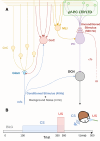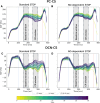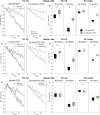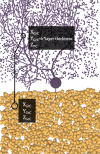Modeling nitric oxide diffusion and plasticity modulation in cerebellar learning
- PMID: 40520650
- PMCID: PMC12165721
- DOI: 10.1063/5.0250953
Modeling nitric oxide diffusion and plasticity modulation in cerebellar learning
Abstract
Nitric oxide (NO) is a versatile signaling molecule with significant roles in various physiological processes, including synaptic plasticity and memory formation. In the cerebellum, NO is produced by neural NO synthase and diffuses to influence synaptic changes, particularly at parallel fiber-Purkinje cell synapses. This study aims to investigate NO's role in cerebellar learning mechanisms using a biologically realistic simulation-based approach. We developed the NO Diffusion Simulator (NODS), a Python module designed to model NO production and diffusion within a cerebellar spiking neural network framework. Our simulations focus on the eye-blink classical conditioning protocol to assess the impact of NO modulation on long-term potentiation and depression at parallel fiber-Purkinje cell synapses. The results demonstrate that NO diffusion significantly affects synaptic plasticity, dynamically adjusting learning rates based on synaptic activity patterns. This metaplasticity mechanism enhances the cerebellum's capacity to prioritize relevant inputs and mitigate learning interference, selectively modulating synaptic efficacy. Our findings align with theoretical models, suggesting that NO serves as a contextual indicator, optimizing learning rates for effective motor control and adaptation to new tasks. The NODS implementation provides an efficient tool for large-scale simulations, facilitating future studies on NO dynamics in various brain regions and neurovascular coupling scenarios. By bridging the gap between molecular processes and network-level learning, this work underscores the critical role of NO in cerebellar function and offers a robust framework for exploring NO-dependent plasticity in computational neuroscience.
© 2025 Author(s).
Conflict of interest statement
The authors have no conflicts to disclose.
Figures






Similar articles
-
Computational Theory Underlying Acute Vestibulo-ocular Reflex Motor Learning with Cerebellar Long-Term Depression and Long-Term Potentiation.Cerebellum. 2017 Aug;16(4):827-839. doi: 10.1007/s12311-017-0857-6. Cerebellum. 2017. PMID: 28444617
-
The Concept of Transmission Coefficient Among Different Cerebellar Layers: A Computational Tool for Analyzing Motor Learning.Front Neural Circuits. 2019 Aug 27;13:54. doi: 10.3389/fncir.2019.00054. eCollection 2019. Front Neural Circuits. 2019. PMID: 31507382 Free PMC article.
-
Mesoscale simulations predict the role of synergistic cerebellar plasticity during classical eyeblink conditioning.PLoS Comput Biol. 2024 Apr 4;20(4):e1011277. doi: 10.1371/journal.pcbi.1011277. eCollection 2024 Apr. PLoS Comput Biol. 2024. PMID: 38574161 Free PMC article.
-
Cerebellar learning mechanisms.Brain Res. 2015 Sep 24;1621:260-9. doi: 10.1016/j.brainres.2014.09.062. Epub 2014 Oct 5. Brain Res. 2015. PMID: 25289586 Free PMC article. Review.
-
Learning-induced structural plasticity in the cerebellum.Int Rev Neurobiol. 2014;117:1-19. doi: 10.1016/B978-0-12-420247-4.00001-4. Int Rev Neurobiol. 2014. PMID: 25172626 Review.
References
LinkOut - more resources
Full Text Sources
Miscellaneous

